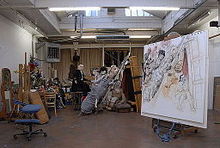3/4 Great Artists in Their Own Words - But Is it Art ? (1966-1993)
Dame Paula Rego, DBE (born 26 January 1935), is a Portuguese visual artist who is particularly well known for her paintings and prints based on storybooks.[1] Rego’s style has evolved from abstract towards representational, and she has favoured pastels over oils for much of her career. Her work often reflects feminism, coloured by folk-themes from her native Portugal. Rego studied at the Slade School of Fine Art and was an exhibiting member of the London Group with David Hockney and Frank Auerbach.[2] She was the first artist-in-residence at the National Gallery in London.[3] She lives and works in London.[4]
Dame Paula Rego, DBE (born 26 January 1935), is a Portuguese visual artist who is particularly well known for her paintings and prints based on storybooks.[1] Rego’s style has evolved from abstract towards representational, and she has favoured pastels over oils for much of her career. Her work often reflects feminism, coloured by folk-themes from her native Portugal. Rego studied at the Slade School of Fine Art and was an exhibiting member of the London Group with David Hockney and Frank Auerbach.[2] She was the first artist-in-residence at the National Gallery in London.[3] She lives and works in London.[4]
Contents
ARTS ON THE AIR | 02.09.2010 | 04:30
Joana Vasconcelos - the rising star of Portugal’s art world
The London-based artist Paula Rego was recently made a Dame of the British Empire and is probably still the best-known artist to emerge from Portugal. Joana Vasconcelos. Alison Roberts caught up with Portugal’s rising star at her Lisbon studio, when she was preparing among other things for her first big one-woman show in London this summer:
(b Lisbon, 26 Jan 1935). British painter and printmaker of Portuguese birth. She trained at the Slade School of Fine Art, London, from 1952 to 1956. There she met the English painter Victor Willing (1928-88), whom she married and with whom she lived in Portugal from 1957 to 1963; they continued to divide their time between Portugal and England until 1975. She first won acclaim in Portugal with semi-abstract paintings that sometimes included collage elements culled from her own drawings. Their satiric wit and verve of line, sometimes applied to violent or political subjects such as Salazar Vomiting the Homeland (1960; Lisbon, Mus. Gulbenkian), revealed gifts for story-telling that had been awakened in her as a child by folk-tales related by a great-aunt. Her diverse influences included Dubuffet, Picasso, Walt Disney, Gilray and magazine illustrations by turn-of-the-century caricaturists.



沒有留言:
張貼留言